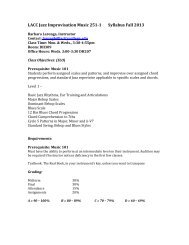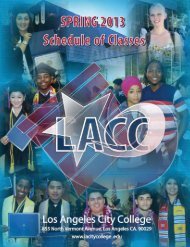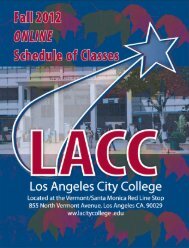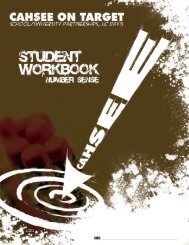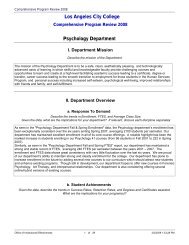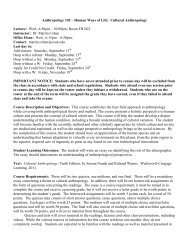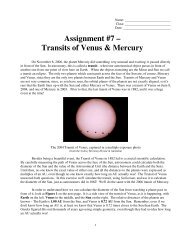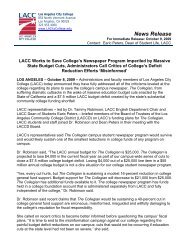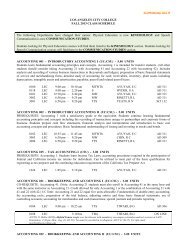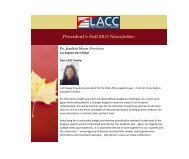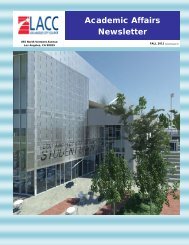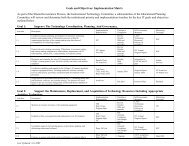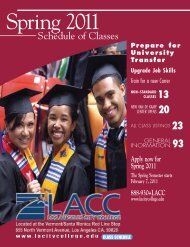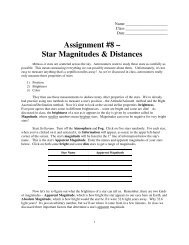LACC Vision & Mission Statements As Approved By - Los Angeles ...
LACC Vision & Mission Statements As Approved By - Los Angeles ...
LACC Vision & Mission Statements As Approved By - Los Angeles ...
Create successful ePaper yourself
Turn your PDF publications into a flip-book with our unique Google optimized e-Paper software.
LOS ANGELES CITY COLLEGE 80TH ANNIVERSARY CATALOG 2008-2009<br />
Cinema majors will develop and write two short screenplays that they will<br />
produce in the advanced motion picture workshop (Cinema 15, 16, 17).<br />
UC limit: 5 combined with Theatre Arts courses: maximum, 12 units (see<br />
Theatre Arts).<br />
CINEMA 6<br />
Motion Picture Photography<br />
3 UNITS - (CSU)<br />
Prerequisite: Cinema 1, 2, 3, 4, with satisfactory grades or better.<br />
Required of all Cinema majors.<br />
Lecture 2 hours. Laboratory 2 hours.<br />
Introduction to cinematography, including optics, photo emulsions, digital<br />
This course is an introduction to cinematography, including optics, photo<br />
emulsion, camera operation, laboratory procedures, terminology and<br />
aesthetics. Students will do individual and group projects using 16 mm or<br />
digital video camera equipment.<br />
CINEMA 7<br />
Advanced Cinematography and Creative Techniques<br />
3 UNITS - (CSU)<br />
Prerequisite: Cinema 6 with a satisfactory grade or better.<br />
Lecture 2 hours. Laboratory 2 hours.<br />
An advanced course in creative cinematography covering sophisticated<br />
professional equipment and techniques used in the motion picture industry.<br />
Emphasis is placed on lighting and current industry standards.<br />
CINEMA 9<br />
Motion Picture Sound<br />
3 UNITS - CSU<br />
Prerequisite: Cinema 1, 2, 3, 4 with satisfactory grades or better.<br />
Lecture 1 hour, Laboratory 4 hours.<br />
Hands-on instruction in the method of recording sound with emphasis on<br />
motion pictures. Areas of study include microphones, production recorders,<br />
location sound recording problems, microphone types and placement,<br />
transfer, ADR, Foley, sound effects, sound editing and mixing<br />
CINEMA 10<br />
INTRODUCTION TO FILM DIRECTING<br />
3 UNITS - CSU<br />
Prerequisite: Cinema 1,2,3, 4 with satisfactory grades or better.<br />
Lecture 2 hours, Laboratory 2 hours<br />
Introduction to the crafts of acting and directing for the film medium; with<br />
emphasis on the visualization of the screen play, the junction of the actor<br />
in interpreting the script, and the role of the director in handling actors in<br />
the production of a film.<br />
CINEMA 15<br />
Motion Picture Workshop I<br />
3 UNITS - (RPT 1) (CSU)<br />
Prerequisite: Cinema 5, 6, 9, 10, 20 and 32 with satisfactory grades or<br />
better.<br />
For advanced <strong>LACC</strong> Cinema students.<br />
Lecture 1 hour. Laboratory 4 hours.<br />
Practical work in 16mm and Digital Video production. Lecture and laboratory<br />
workshop emphasizing the creative use of the camera, editing,<br />
sound, and production activities in relation to the fiction film format. Each<br />
student will be responsible for making a short film.<br />
CINEMA 16<br />
Motion Picture Workshop II<br />
3 UNITS - (A)<br />
- 84 -<br />
Prerequisite: Cinema 5, 6, 9, 10, 20 and 32 with satisfactory grades or<br />
better.<br />
For advanced <strong>LACC</strong> Cinema students.<br />
Lecture 1 hour. Laboratory 4 hours.<br />
The production of a short film or video project from script development<br />
and production packaging to the actual shooting, editing and mixing of<br />
the film or video.<br />
CINEMA 17<br />
Advanced Motion Picture Post-Production<br />
3 UNITS - (A)<br />
Prerequisite: Cinema 16 with a satisfactory grade.<br />
Lecture 1 hour. Laboratory 4 hours.<br />
Advanced film post-production methods are applied as students learn to<br />
prepare for release of a short film that has been produced in Cinema 15<br />
and 16. Included techniques are flatbed or digital editing, foley effects,<br />
automatic dialog replacement, and re-recording.<br />
CINEMA 20<br />
Business <strong>As</strong>pects of Motion Picture Production<br />
3 UNITS - (A)<br />
Lecture 3 hours<br />
Prerequisite: Cinema 1, 2, 3,4, with satisfactory grades or better.Survey of<br />
business practices including financing, production and distribution.<br />
CINEMA 22<br />
Digital Audio Post Production with Pro Tools<br />
3 UNITS - (A)<br />
Lecture 2 hours. Laboratory 2 hours.<br />
Prerequisite: Cinema 9 or 11 or 32 or Television 52 or 55 with a satisfactory<br />
grade or better. Advanced television and cinema students are introduced<br />
to digital audio editing, multi-track mixing and other digital audio postproduction<br />
with ProTools<br />
CINEMA 25<br />
Producing Digital Video Features<br />
3 UNITS - (A)<br />
Lecture 3 hours<br />
Digital Video (DV) has transformed feature film production and<br />
distribution. Explore this new frontier and its new and proposed uses on<br />
the Internet.<br />
CINEMA 32<br />
Editing Fundamentals<br />
3 UNITS - (A)<br />
Prerequisite: Cinema 1, 2, 3 and 4 with satisfactory grades or better.<br />
Lecture 1 hours. Laboratory 4 hours.<br />
Intermediate students will learn the basics of editing with basic non-linear<br />
digital equipment.<br />
CINEMA 33<br />
Digital Video Production Workshop I<br />
3 UNITS - (A)<br />
Prerequisite: Cinema 1, 2, 3, and 4 with satisfactory grades or better.<br />
Lecture 1 hours. Laboratory 4 hours.<br />
Intermediate students will produce short video projects using basic digital<br />
video cameras and editing systems.



